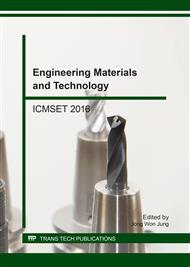p.448
p.454
p.459
p.465
p.471
p.477
p.481
p.488
p.494
Relaxation of Structural Concrete due to its Shrinkage in Terms of Age-Adjusted Effective Modulus Method
Abstract:
This paper focuses on the calculation of residual stresses due to shrinkage with a tensile creep effect. Whereas the shrinkage of concrete causes stresses in the material, the tensile creep counteracts the shrinkage as a stress relaxation mechanism. The main objective of this paper is to evaluate the ageing coefficient c (referred to as Trost-Bazant Coefficient) reflecting the load history. The coefficient is used for the residual stress analysis by means of a simplified method called Age-adjusted Effective Modulus Method. The tensile creep effect was evaluated according to the rheological model provided by Eurocode 2. Although the Eurocode predicts the creep for the structural members subjected to compressive stresses, this study proves that it can be used for the tensile creep prediction as well. We tested three types of concrete: reference concrete, high-performance concrete with reduced shrinkage magnitude by means of special admixtures, and fibre concrete with the content of polypropylene fibres. From the obtained results, it can be stated, that the ageing coefficient can be considered to be the value of 0.45 for any shrinkage development. It was also proved, that the tensile creep value essentially affects the magnitude of residual stresses, even in the “early age” concrete. The correctness of the calculated residual stresses was verified by means of a Ring-test.
Info:
Periodical:
Pages:
471-476
Citation:
Online since:
June 2017
Authors:
Keywords:
Price:
Сopyright:
© 2017 Trans Tech Publications Ltd. All Rights Reserved
Share:
Citation:


